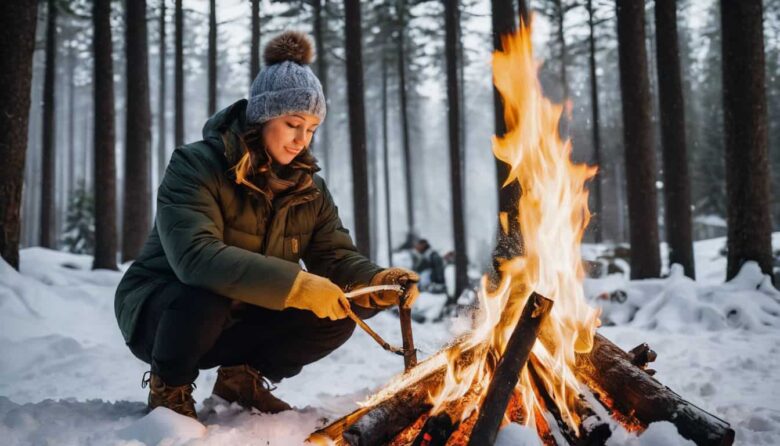The sight of fire sparked terror into the minds of our ancestors when it wasn’t clear exactly how it could be made, partly due to the capability of fire and the devastation it could cause when uncontrolled. Humans have evolved, and we now understand more about fire than ever. When did we reach that point?
Here, we will explain the story of fire, its uses over time, and why it has immeasurably changed the course of human existence.
The Origins of Fire

Depending on the research you listen to, the fire could have existed as long as 420 million years, with evidence from caves in part of Africa helping archaeologists trace it back to that long ago; how these fires would have been ignited isn’t certain, but a combination of a fuel source, oxygen, and even incidental ignition can cause fire anywhere.
However, humans are unlikely to have used fire until much more recently. Parts of modern-day Israel show evidence of humans sustaining fires around 300,000 to 400,000 years ago, most likely for cooking meat. It’s difficult to understand when humans learn how to ignite fires reliably. Still, it is generally agreed that it wasn’t for thousands of years after discovering how to sustain it.
Wood was abundant in many parts of the world, so early humans were never short of a fuel source. The soot and remnants from burned wood were used to help soil grow more and provide heat and light. Fire quickly became central to survival, not only for warmth in colder climates but also for defense, as it served to protect humans from predators and insects, creating a safe perimeter.
The power of fire also facilitated social and cultural development. Sitting around a fire provided a communal space for early humans to gather, share stories, and develop language and social bonds. This simple act of gathering around a fire led to the early social structures that would shape human civilizations. Fire wasn’t just a survival tool—it was a medium that fostered community and communication, factors vital for human evolution.
Human Advancement and Fire Use Changes

How did humans find themselves on top of the food chain? Fire is a big reason for this, giving the species an advantage to hunt, forge weapons, cook more easily, receive more warmth, and navigate in the dark. It’s impossible to believe humans would have never discovered fire at some point, but it is interesting to imagine what our species, and if it would have survived, were fire never around.
Fire allowed early humans to experiment with cooking methods that made previously inedible foods consumable. Cooking meat, for instance, made it easier to digest and reduced the risk of foodborne illnesses. This advancement not only improved health but also allowed early humans to develop a broader diet. With this dietary expansion came improved nutrition, leading to greater physical and cognitive growth over generations. Fire’s impact on diet and health is one of the primary reasons our species evolved into what it is today, as it provides the necessary energy and nutrients to support a growing and complex brain.
Over time, humans learned to harness the energy from fires to heat homes, provide consistent light at home, power transportation, signal to others afar, and more. Nearly all of the contemporary tools and appliances we use today are here thanks to the discovery and utilization of fire and its energy.
With the development of metallurgy, humans could create stronger tools and weapons, further advancing agriculture and construction. Fire made it possible to melt metals, creating the foundation for the Iron and Bronze Ages. Metallurgy changed human life dramatically; it led to improved farming tools that allowed for surplus food production, which in turn led to settled societies and the development of cities. This technological leap was made possible by fire, as metal extraction and shaping required the controlled use of flames at high temperatures.
With these advancements, humans have noticed more of the adverse effects burning unseasoned wood or less energy-dense forms of coal can lead to, like environmental damage and respiratory health concerns. Therefore, there’s a greater consciousness of substituting traditional house coal with smokeless fuel.
In the last few centuries, fire’s role has become even more complex. The Industrial Revolution brought with it machines powered by coal and, eventually, oil. This shift sparked incredible growth in manufacturing, transportation, and urbanization but also initiated long-term environmental impacts. Fossil fuel combustion has contributed significantly to air pollution and climate change, issues that our ancestors couldn’t foresee when first harnessing fire. This awareness has led to innovations aimed at reducing dependency on polluting fuels.
We now understand the amount of moisture within a wooden log that is considered safe to burn. Kiln-dried logs are the best approach to burn safely and efficiently. Always opt for kiln-dried wood or smokeless coal when making your next solid fuel purchase. Additionally, there has been an increased push toward clean energy sources, such as solar and wind, as well as a re-evaluation of how we use fire-derived energy sources in daily life. The challenge of balancing fire’s benefits with its environmental impact is a central focus in modern energy policies and sustainability efforts.
The evolution of fire usage reflects the path of human civilization itself. What began as a natural phenomenon that sparked fear has turned into a crucial tool that humans have learned to master and adapt to various needs over millennia. The story of fire is, in essence, the story of human ingenuity and adaptability.

